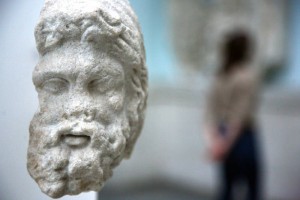
In the late 19th century, when the German Empire had just been formed, a railway engineer excavated the city of Pergamon in what is modern-day Turkey.
There he discovered an ancient sacrificial altar and took it with him to Berlin. Built to represent the Attalid dynasty’s power in the Second century BC, the temple symbolised perfectly the imperial supremacy of the Germans at that time. Eventually, in the early twentieth century, the Pergamon Museum was built to house many of the objects discovered during the massive excavations. The late addition to Museum Island would be surrounded by conflict and disputes over possession in the years to come. On October 15th ECLA students had the opportunity to visit the Pergamon Museum and view important artefacts first-hand.
As we have been told by Hesiod, there was once a “grim battle” between the gods and the Titans, where, “[Zeus’] bolts flew thick with thunder and lightning from his massive hand”. This battle scene is depicted in the frieze surrounding the lower part of the Pergamon Altar. One can have a close look at the dramatic and muscular portrayal of the gods as they fight back the half-serpent and half-human giants.
At the end of World War II, the Red Army took these pieces to Leningrad as war trophies, but they were returned to Berlin in 1959 and were again put on display. Upon entering the exhibition room, one is faced with an overwhelming complex of stairs, sculptures and columns that makes the modern mind travel back to the golden days of this enormous harbour city. Additionally, the photorealistic 360°-panorama of Pergamon, displaying what the city might have looked like in 125 AD in the forecourt of the museum, is worth repeated visits and viewings.
Even though the Museum has been named after this one special artefact, many more impressive excavations can be found incorporated in the museum halls. Passing through the second-century Market Gate of Miletus, one reaches the Ishtar Gate of Ancient Babel, and is struck by the colourfully-glazed paintings of lions and daisies that managed to survive several millennia on the walls of the Procession Alley.
The Mshatta Facade in the next room, dating from around 800 AD, was appropriately compared to “honey combs” by a student, with its delicate zigzag ornaments dragging the viewer into the long-forgotten world of the Jordanian Bedouins.
In fact, another relic that used to be exhibited has just been returned to Turkey a few weeks ago. The 3000 year old Sphinx of Hattusa that had been displayed at the Pergamon Museum since 1934 was fought over by the Germans and the Turkish in a battle about its legitimate ownership. Such disputes are very common today, since many countries want to recover artefacts they claim have been unlawfully appropriated.
In the case of the Sphinx, victory was on the Turkish side, and Berlin is currently working on replacing the relic with a plaster copy.
Either way, this permanent exhibition abducts the visitor to the worlds of gods and heroes, of Bedouins, merchants and flying carpets, and while looking at the relief, one can almost hear, as Hesiod would put it, “the blazing glow of thunder and lightning” on Mount Olympus.
by Johanna Fürst (AY’12, Austria)
